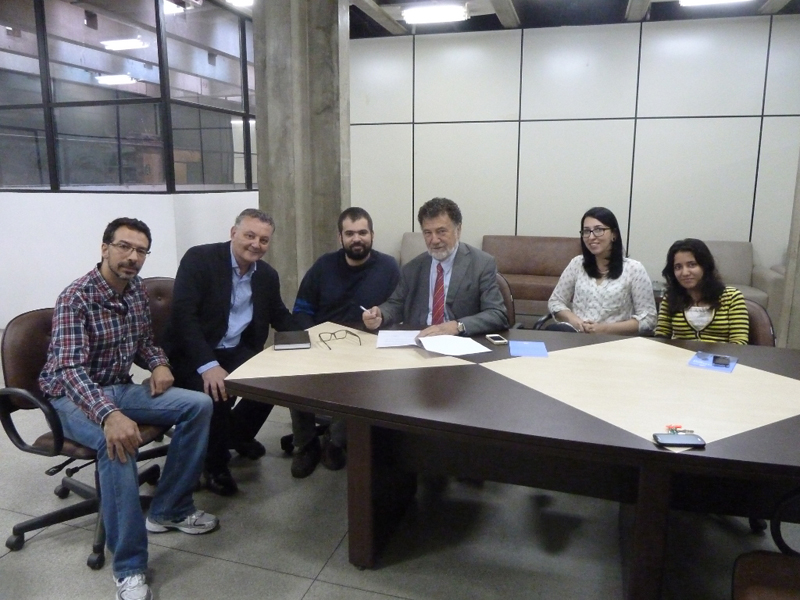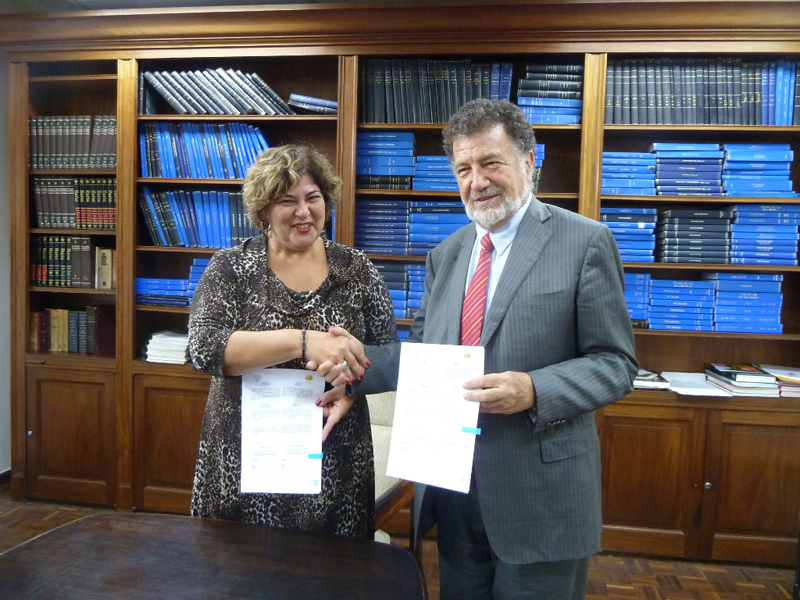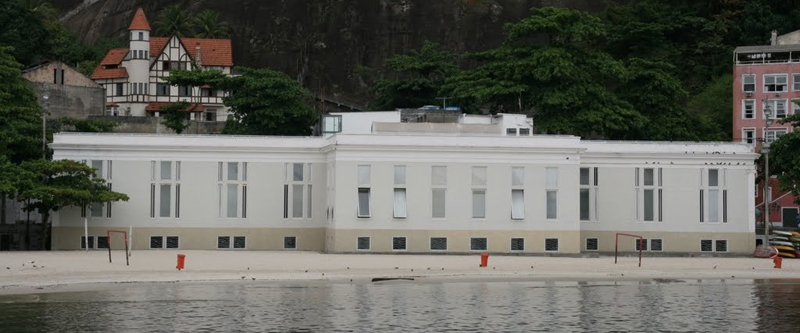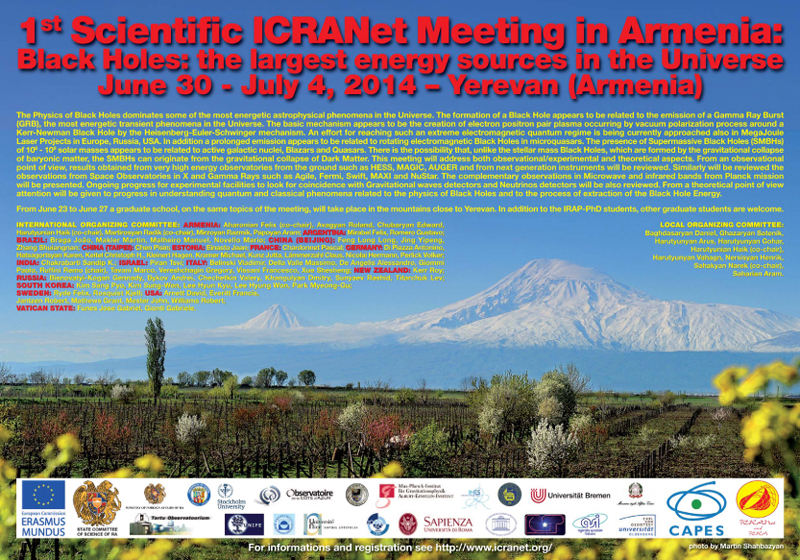

| Newsletter English May/June |

|

|





ICRANet Newsletter
May/June
Supernovae, gamma-ray bursts and induced gravitational collapse
Workshop in Les Houches (France)
The workshop, promoted by ICRANet within the International Relativistic Astrophysics Ph.D. Program (IRAP PhD), co-sponsored by the Erasmus Mundus program of the European Commission and by the CAPES-ICRANet program and co-organized by Pascal Chardonnet, Georges Meynet and Remo Ruffini, was held in Les Houches, France, in May 11-16, 2014. It led to several important new results on the astrophysical quest for the progenitor systems of very energetic (1052–1054 erg) long gamma-ray bursts (GRBs) associated with supernovae (SNe), for the physical mechanisms at work and also for the subsequent cosmological implications. GRBs are flashes of gamma-rays which happens almost daily in the sky. They are the most energetic events of the entire Universe, emitting in a few seconds in gamma-rays the same amount of energy emitted in that same seconds in all the bands of the electromagnetic spectrum (from radio waves to gamma-rays) by all the other celestial bodies together. GRBs are emitted at the formation of a black hole. They are defined to be “long” when their observed duration is longer than 2 seconds, and “short” otherwise. Some of the “long” GRBs appear to be also associated to Supernovae (SNe), the explosions corresponding to the final stages of the life of massive stars. The association between GRBs and SNe, in the case of GRBs with a total energy emitted larger than 1052 erg (i.e. two hundred million times larger than the energy radiated by all the stars in our Galaxy in one second), can be explained within the Induced Gravitational Collapse (IGC) paradigm, first introduced by Prof. R. Ruffini and collaborators in 2001 and later revisited at The 10th Marcel Grossmann Meeting held in Berlin in 2006. The progenitor of these GRB-SN sources is assumed to be a tight binary system composed of two bodies: an evolved core (mainly formed by Iron, Carbon and Oxygen, hence named “FeCO”) of a massive star on the verge of a SN explosion and a companion neutron star (NS). These special systems are named “binary driven hypernovae” (BdHNe).
Most important has been the participation to the meeting of Prof. Christopher L. Fryer, purposely flown in from the Los Alamos National Laboratories, as well as of Mackenzie Warren, from the University of Notre Dame in South Bend (Indiana, USA), which have shown important progresses in applying to the above IGC paradigm the numerical codes of SN explosions developed through many years at Los Alamos by Chris Fryer and David Arnett and by Jim Wilson at Livermore, later extended at the University of Notre Dame by Grant Mathews and his group. The meeting was also enriched by the observation of GRB 140512A on May 12th, detected by the Swift and the Fermi satellites. The entire group of research of ICRANet has demonstrated the direct application of their model to the study of the GRB day after day. It has been so that Giovanni B. Pisani and Ana Virginia Penacchioni were able to predict the redshift between 0.6 and 1.1 out of the first principle of the theory, which was later observed on May 19th by the NOT telescope at the Canary islands to be z = 0.725. In the above figure the prediction was presented on the blackboard. The school has been particularly lively by the presentation of the results of the many students under the guidance of the ICRANet Faculty (C.L. Bianco, L.Izzo, J. Rueda, S.-S. Xue) as well as the collaborating scientists Prof. Massimo Della Valle, director of the Naples Observatory, and Aleksei Aksenov from Moscow. In particular, L. Izzo showed the possibility that BdHNe progenitor systems are also at very high redshift (z=8.2, roughly 650 million years after the Big Bang), with very important implications from a cosmological point of view, i.e. the possibility to use GRB as distance indicators and to test the Universe stellar population at high redshift. Other important results were presented by Marco Muccino and Yu Wang, PhD students of the IRAP PhD Program. The analysis on the prototypical BdHN, GRB 090618 [Ruffini et al. A&A (2014); see highlights below], evidenced that the BdHN X-ray luminosity originates from the wide angle emission of the SN ejecta, rather than from the GRB. This aspect is reflected by the presence of a nested structure and a common late power-law behavior in the X-ray luminosities of all the BdHNe [Pisani et al. A&A (2013)], which appears to maintain the same scaling law also in the optical, gamma and high energy emissions [Ruffini et al., ApJ submitted (2014)]. 
Highlights on an ICRANet publication of this month: On binary driven hypernovae and their nested late X-ray emission
In the paper by Rueda and Ruffini, Astrophysical Journal Letters (2012), 758, L7 it has been described the rapid evolutionary sequence of these systems, which consists of four distinct emission episodes, observed in the prototypical source GRB 090618 and described in the paper by Izzo, Rueda and Ruffini, Astronomy & Astrophysics Letter (2012). A brief summary of this time sequence is outlined: Episode 1 corresponds to the FeCO core explosion as a SN, with the consequent birth of a new NS (named ν-NS) as the remnant; part of the SN ejecta triggers an accretion process onto the NS companion, and a prolonged interaction between the ν-NS and the NS binary companion occurs. Episode 2 corresponds to the actual GRB; it occurs when the companion NS reaches its critical mass and gravitationally collapse to a black hole. Episode 3, observed in the X-rays, corresponds to an emission with a very precise behavior in time, consisting of a steep decay, starting at the end point of Episode 2, and then a shallow decay phase (or a plateau), followed by a late common power-law decay. Episode 4 corresponds to the optical SN emission occurring after ~10–15 days in the source cosmological rest frame.
In the paper by G.B. Pisani, L. Izzo, R. Ruffini, C.L. Bianco, M. Muccino, A.V. Penacchioni, J.A. Rueda, and Y. Wang, Astronomy & Astrophysics Letter (2013), 552, L5, it has been pointed out the most striking feature of these BdHNe: the common behavior in their late Episode 3 emission. No matter what is the total energetics of the whole event, the duration of Episode 1 and 2, or the distance from the observer of these systems, when we compute the amount of energy emitted per unit of time (luminosity) in a common energy band, the late Episode 3 emission at times larger than 104 s follows the same behavior in time and luminosity, providing a perfect overlap. This feature, in principle, would make these sources a possible distance indicator and suggests that the underlying physical mechanism must be the same in all of them. In the recently published work by R. Ruffini, M. Muccino, C. L. Bianco, M. Enderli, L. Izzo, M. Kovacevic, A.V. Penacchioni, G.B. Pisani, J.A. Rueda, Y. Wang, 2014, Astronomy & Astrophysics, 565, L10, which is the subject of these highlights, we report the first attempt to give a global physical insight on the origin of Episode 3. One of the results of this work concerns the size of the emitting region where the Episode 3 originates, inferred from the analysis of the prototypical BdHNe, GRB 090618. During the steep decay phase of its Episode 3, a thermal component has been observed in the X-rays. Beyond its very physical meaning, a thermal spectrum is the only emission model which can provide a direct estimate of the size of the emitting region. In the present case it has been inferred the initial size of the source of ~1013 cm, which expands at 0.9 times the speed of light c. This represents the evidence that Episode 3 X-ray luminosity of these sources originates from the wide angle emission of the SN ejecta, rather than from the GRB as it was purported before, since the GRB has typically much higher expansion velocities and, therefore, larger typical dimensions of the emitting region of ~1016-1017 cm (see figure above). The steep decay, the plateau, and the late power-law decay in Episode 3 luminosities for three selected BdHNe (GRB 060729, GRB 061121, and GRB 130427A) were compared and contrasted. Not only these selected BdHNe present a late time overlapping, but they evidence further properties: the higher the energetic of the source, the shorter the plateau phase duration, while the late time emission always overlaps following a precise power-law decay. This represents an authentic nested structure (see figure below). In particular, with the inclusion of all our best known sample of BdHNe, precise scaling laws involving the plateau duration and luminosity, as well as the average luminosity of prompt emission have been inferred. The common asymptotic late power-law behavior in all BdHNe can be explained by the role of r-process, which are responsible of creating heavy elements. The best scenario for the r-process occurs during the merger of binary NSs (i.e., during the interaction of the companion NS with the ν-NS), where a very neutron-rich dense medium favors the production of nuclei heavier than iron. These are unstable and then decay in lighter daughter nuclides, generating a cascade of reactions, which represents the “fuel” that keeps the late Episode 3 emission going on. Recent computations of the luminosity obtained by the r-process provide a power-law with slopes -1.4≤α≤-1.1 [see the paper by B. D. Metzger, G. Martınez-Pinedo, S. Darbha, E. Quataert, A. Arcones, D. Kasen, R. Thomas, P. Nugent, I. V. Panov and N.T. Zinner, (2010) Monthly Notices of the Royal Astronomical Society, 406, 2650], strikingly similar to the ones we have found in the late Episode 3 X-ray luminosity.
ICRANet activities in Brazil and Latin America
During his visit to Brazil in the last week of May, Prof. Ruffini, Director of ICRANet, participated in several events which attest to the vitality of our institute in the South American country.
After having convened an extraordinary meeting of the Scientific Committee and the IRAP PhD Faculty at the CBPF - Centro Brasileiro de Pesquisas Físicas in Rio de Janeiro, Prof. Ruffini was involved in two important ceremonies. The first celebrated the signing of the agreement between ICRANet and UFF - Universidade Federal Fluminense in the seat of Niteroi, RJ. The second renewed the five-year agreement with UERJ - Universidade do Estado do Rio de Janeiro, first signed back in 2009. Both agreements, together with those already signed with CAPES, CBPF, FAPERJ, the Government of the State of Ceará, ITA, UFPB, UFRGS, UNIFEI, and INPE, are strategic for international scientific research and represent a major growth opportunity for scientists and researchers from Europe and South America. In addition, Prof. Ruffini met Franklin Dias Coelho, Secretário Especial de Ciência e Tecnologia of the Município do Rio de Janeiro, participated in the inauguration of the headquarters of IED - Instituto Europeo di Design, in the prestigious historical Cassino da Urca, and further advanced the project there of the two Institutes of ICRANet and of IED “from the Design of Men to the Design of the Universe”. Noteworthy also the attribution of the Honorable mention 2014 by the Gravity Research Foundation received by C. R. Argüelles and Professor R. Ruffini for a work based on a novel approach which simultaneously deals with super massive black holes and dark matter halos in galaxies (http://arxiv.org/abs/1405.7505). Announced also the upcoming signature of the Agreement ICRANet – UAM Universidad Autónoma Metropolitana in Mexico City on the July 9th between the Rector of UAM, Dr. Salvador Vega y León, and the Director of ICRANet, Professor Remo Ruffini. This signature follows the agreement between ICRANet and UNAM Universidad Nacional Autonoma de Mexico which is fully operative (http://www.icranet.org/docs/UNAMsigned.pdf).
1st Scientific ICRANet Meeting in Armenia
The Physics of Black Holes dominates some of the most energetic astrophysical phenomena in the Universe. The formation of a Black Hole appears to be related to the emission of a Gamma Ray Burst (GRB), the most energetic transient phenomena in the Universe. The basic mechanism appears to be the creation of an electron-positron pair plasma occurring by a vacuum polarization process around a Kerr-Newman Black Hole by the Heisenberg-Euler-Schwinger mechanism. An effort of reaching such an extreme electromagnetic quantum regime is being currently approached also in MegaJoule Laser Projects in Europe, Russia, and the USA. In addition a prolonged emission appears to be related to rotating electromagnetic Black Holes in microquasars. The presence of Supermassive Black Holes (SMBHs) of 10^8 and 10^9 solar masses appears to be related to active galactic nuclei, Blazars and Quasars.
There is the possibility that, unlike the stellar mass Black Holes, which are formed by the gravitational collapse of baryonic matter, the SMBHs can originate from the gravitational collapse of Dark Matter. This meeting will address both observational/experimental and theoretical aspects. From an observational point of view results obtained from very high energy observatories from the ground such as HESS, MAGIC, AUGER and from next generation instruments will be reviewed. Similarly the observations from Space Observatories in X and Gamma Rays such as Agile, Fermi, Swift, MAXI and NuStar will be reviewed. The complementary observations in microwave and infrared bands from the Planck mission will be presented. Ongoing progress for experimental facilities to look for coincidence with gravitational wavedetectors and neutrino detectors will also be reviewed. From a theoretical point of view attention will be given to progress in understanding quantum and classical phenomena related to the physics of Black Holes and to the process of extraction of the Black Hole Energy. Before the 1st Scientific ICRANet Meeting “Black Holes: the largest energy sources in the Universe” from June 30 to July 4, an IRAP PhD School for graduate students will be organized from June 28 to June 29 in Aghveran. A preliminary program of the meeting can be found here: http://www.icranet.org/images/stories/Meetings/meetingArmenia2014/preliminary_program.pdf Please download the poster from: http://www.icranet.org/images/stories/Meetings/meetingArmenia2014/Poster_Armenia_Yerevan_2014.pdf |
|
||








